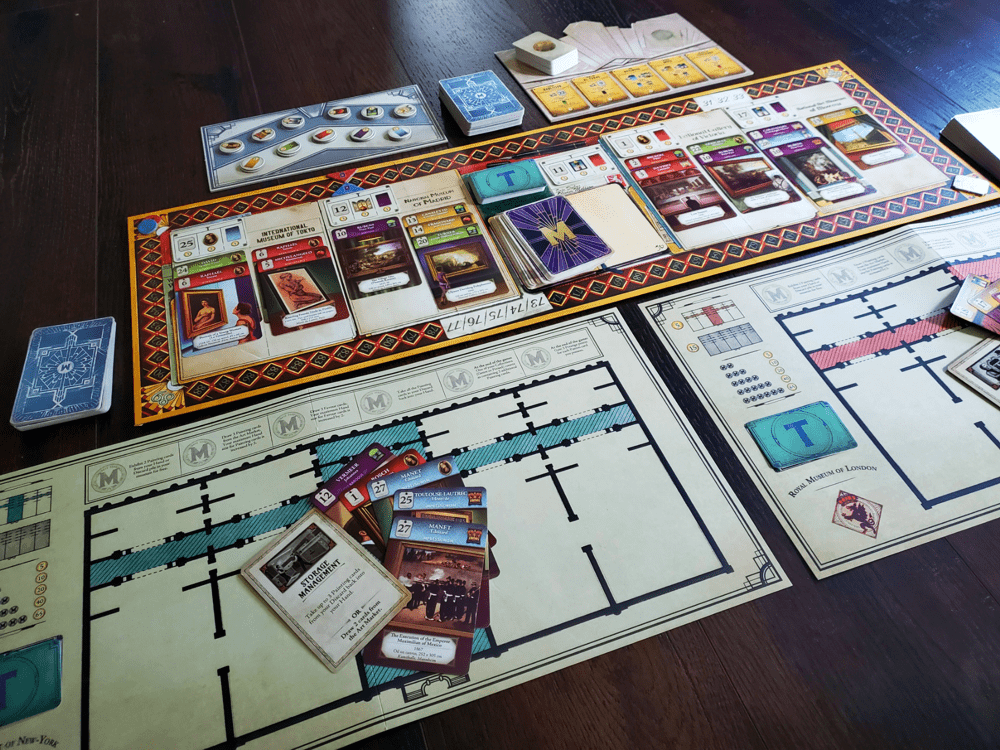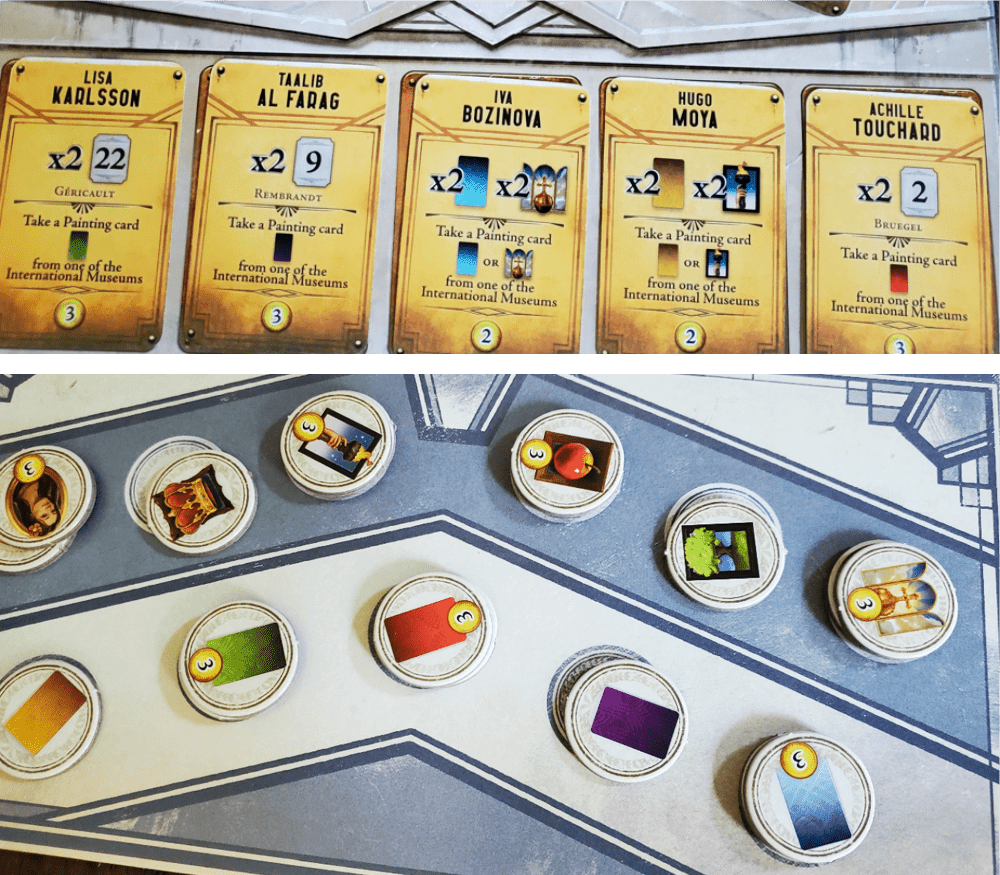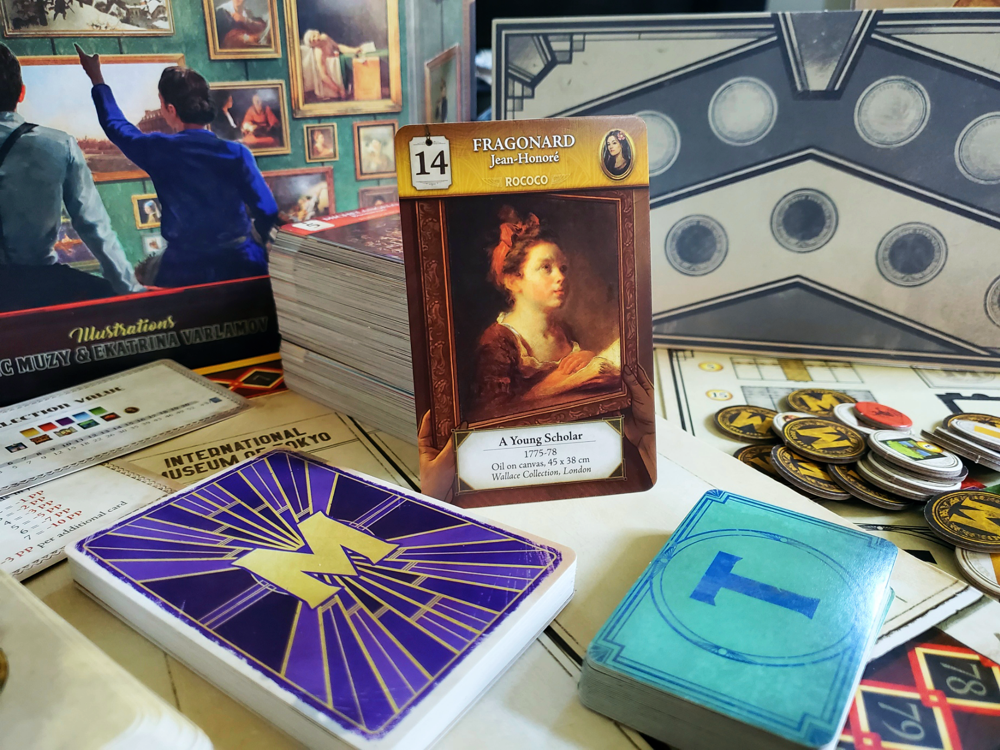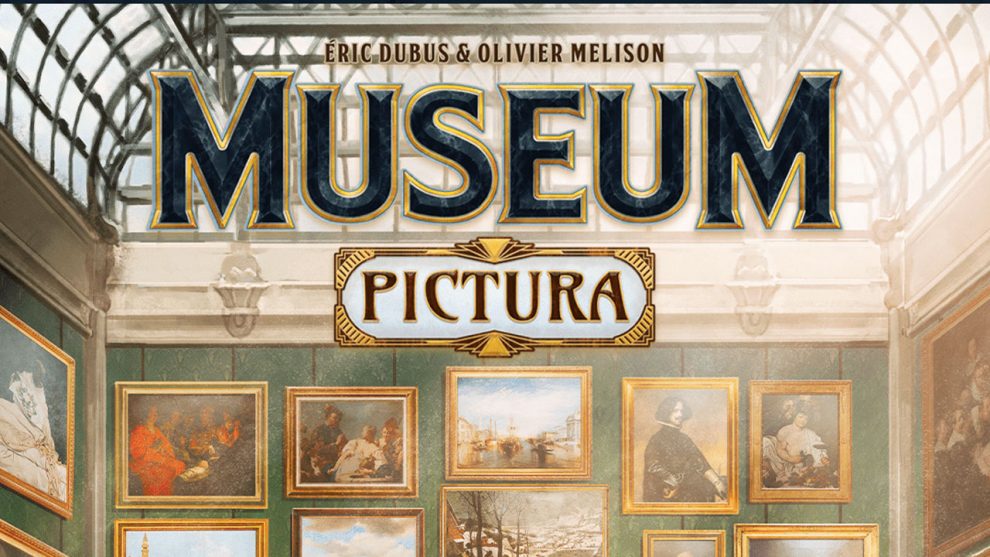Disclosure: Meeple Mountain received a free copy of this product in exchange for an honest, unbiased review. This review is not intended to be an endorsement.
Because we humans love to draw analogies in our heads, it might be helpful if I said, “this new title reminds me of (insert name of puzzly dice game).” But some might cry foul that I’ve not given the game a chance to stand in the spotlight. Likewise, if I said, “Ah, I feel the same way about (insert name of a famously beautiful card-laying game),” you might think I was unfairly covering one work of art with another.
Whether fair or foul, I have every intention of drawing those analogies. But I’ll make you a deal: I’ll help you get to know the game first before I drag something else in front of it.
Museum: Pictura is the stand alone sequel to Museum, the 2019 release from Holy Grail Games. Both titles were designed by Eric Dubus and Olivier Melison, who recently finished a wildly successful Kickstarter run with Encyclopedia.
Players take up the role of museum curators in charge of gathering an impressive art collection from some of the largest cities on Earth. They are subject to the trends of their city and the world at large, trying to satisfy patrons and build the most fluid and seamless experience for their visitors. At heart, Museum: Pictura is a puzzle of cards and timing that presents a fair amount of interaction at the table.
Even with a footprint like Sasquatch
From the first glimpse into the box, Museum: Pictura is a bit of a bear to get rolling.
The central board, aside from the Prestige track, consists of four worldwide museums that will act as trading partners for the players throughout the game. Trend cards guide the preferences for each museum regarding a favorite artist, period, and genre. Each museum receives four paintings which are organized according to the Trends. The middle of the board also holds Favor cards and displays one global Trend card which changes every round for scoring according to the fickle tastes of the general public.
Two smaller boards sit on either side. The Temporary Exhibition board keeps several scoring tokens warm until claimed by a player. The Patron board holds an ever-rotating cast of cards representing wealthy individuals who will aid a player’s cause should the right combinations of paintings hit the showroom floor.
The 180 beautiful painting cards feature works by thirty artists spanning five historical periods and six genres. There are more than enough paintings to break the deck into several smaller portions around the table.
Each player board is a rather sizable museum blueprint which will hold up to a 5×5 grid of paintings. The boards are quite informative, though, with aids for scoring, explanations of Temporary Exhibition bonuses, and a private personal Trend card that scores at the end of the game based on the displayed artwork.

And enough tiny gears to build a Rolex
On each turn, players begin by drawing two painting cards from the smattering of decks—the Market—after which they must trade one card with one of the museums on the central board. These trades are designed to massage the Trends for points. Players will gain Prestige points for giving paintings that align with the museum’s Trends and lose Prestige for robbing these worldwide partners of their favorites.
After the active player makes their required trade, all players then have the option of trading as well, which keeps the table quite active throughout the game while also keeping the scoring quite fluid as players gain and lose points trying to posture themselves for glory.
The active player then takes one of three main actions. First, players may lay any number of paintings into their museum, discarding one painting card for each as a cost. Discard piles are private and quite fluid, serving as a storage warehouse of sorts. They are so fluid, in fact, that players may lay cards from any other discard pile into their museum as if the cards were in their hand. Players who do so must trade one Prestige point as an additional payment, but the cost is worthwhile if the painting fits.
The paintings are the puzzle in Museum. The top of each card features a colored banner indicating the time period, an icon indicating the genre, and a number as shorthand for the artist’s name. By the game’s end, cards must be arranged in orthogonally adjacent patterns connecting the period and genre—Baroque near Baroque, portraits near portraits, etc.—creating a smooth exhibit that is presumably pleasing to the wandering eye of the general public. Cards overlap one another in vertical columns, leaving the top banners visible to align the proper attributes.
As a second possible action, players may pick up their discard pile into their hand. This action comes with a new Favor card and a reset of the Patron board in the hopes of revealing a solid match. Favor cards are one-off abilities that provide additional painting cards, enhancements to the game’s actions, or straight Prestige points. Patrons grant extra cards or points if their perfectly reasonable demands for, say, Impressionist religious works are satisfied.
The third action is a Temporary Exhibition. When a player has a collection of four or more paintings in a particular period or genre, they may declare an Exhibition, which comes with several perks. First, that exhibition is scored on a sliding scale according to the number of cards. More paintings equal more Prestige, but waiting means someone else might Exhibit first. Each Exhibit comes with a token that can then be applied to one of six special abilities. These include increasing hand size, bonus actions, and endgame scoring benefits. There are only two tokens for each Exhibition, with the first one granting additional points, which makes timing a key factor.

Finally, there are a few minor actions that are always available. Once each turn, a player may lay a Favor card to claim its ability. Likewise, if their museum display satisfies a Patron card, one may be claimed with its benefit. Every time a player’s score crosses the next decade (10 Prestige points), they gain a new Favor card.
The endgame drops when someone reaches 50 Prestige points, or when a player’s museum is full and they cannot run a Temporary Exhibition. Then the scoring festival begins.
At the endgame, players must decide on the final locations of paintings before scoring every collection containing four or more connected cards. There are eleven possible collections here, though most museums will only contain a handful of focused groups. It doesn’t take quite as long as you might imagine. There is a bonus for filling a central cross of nine paintings with a single period or genre, and one for filling the museum entirely. There is also a bonus for collecting those Temporary Exhibition tokens. Private Trend cards are scored, granting points for each matching artist, period, and genre in the museum. Finally, there is a penalty based on the number of cards in that pesky discard warehouse.
Whew! After all the math settles, the player with the highest Prestige score wins.
We must be careful not to cast shadows
I’ll say it up front, I really enjoy the puzzle of Museum: Pictura. I get distinct Sagrada vibes from this one, only with cards instead of dice. Throughout the game, the aim is to align two qualities on a grid—period and genre—which are akin to the number and color in the stained glass beauty. Sagrada is a beloved title in our house, so the puzzle is a definite win.

I also get a few Wingspan vibes, but for mixed reasons. First, the sheer number of cards triggers the PTSD from both the variability and the impossibility of its avian cousin. Like Wingspan, countless helpful cards will remain buried in the pile when all is said and done. Though not a gamebreaker in terms of strategy, it is possible that four or even five of the painting cards from a coveted artist will never see the carefully engineered light of the exhibit floor.
Second, like Wingspan, the cards in Museum: Pictura are absolutely gorgeous because they hold many of the greatest works of art ever created. However, where Museum falls short by comparison is that this art is largely neglected throughout the game because the cards are designed to cascade one atop another, leaving only the stats to view. Artists are reduced to their numbers, periods to their color, and genres to their icon. It’s hard to appreciate the cards as anything more than their symbology. This is a punch in the aesthetic kidneys.

Otherwise we may miss the beauty
Let’s consider the time. Our first game—at two players—took two hours. If you couldn’t surmise from the rules overview, this thing is also a bear to learn. As is so often the case, there is a rhythm hidden behind the many, many details and games get shorter and shorter with repeated plays. We’ve now managed a four-player outing in less than two hours, and we have that two-player down to a solid 45 minutes.
When it comes to the potentially complicated teach, I would recommend setting up an established museum and working backward from the card patterns. It is so challenging to describe and envision the reason for all of the rigamarole of the turns without a clear view of the end. I believe a dozen arranged cards and a sample turn will work wonders toward building understanding. Thankfully, the rulebook is quite helpful as a teacher and a reference.
With those two cautions in the rear view, there are fantastic strategic and tactical decisions throughout Museum: Pictura. The trades with the central board can be both agonizing and lucrative, especially the mandatory trades for the active player. Sometimes everything lines up for a great move, and other times you just don’t want to do it! The ebb and flow of the ever-changing global Trends keep every player’s eyes alert to acquire and utilize the right paintings at the right moment. Proper discard pile management is a must—knowing when to gather a quantity of cards to release as payment while simultaneously keeping the most useful cards from the competition and minimizing that endgame penalty. Simply put, there is tension all over and attention all around the table. I consider that a reasonable compensation for the potential length of the game.

I would argue the theme is alive and well in this museum. Rather than taking the perspective of an artist, patron, or visitor, players act as curators. This is the aspect of the theme that enables me to partially forgive covering up those precious works of art. For the curator, I’m sure there are times that exhibits can feel like little more than commodities chosen according to the whim of market forces and the will of the people. I’m sure the task is not always easy, and not always beautiful, but I still want to see those cards! I want to get familiar with Gaugin, spend time with Cézanne, and ask questions of Géricault in the downtime. I cannot help but feel this is an underutilized asset.
Setting aside the steep learning curve for what is a moderately complex game, I have thoroughly enjoyed Museum: Pictura. My 12-year-old gamer daughter had no trouble grasping the concept. Our adult friends had a lovely time with the puzzly depth. I’m happy to keep this one around for a while to see what we can accomplish within the system. There are currently two expansions available which were not provided for the review. I am curious, but as they seem to add even more explanatory cogs to the machine, I’m in no rush.
Though we would rather look at the cards than bury them, at the end of the day, we dig the puzzle and the opportunity to tinker in the world of artistic wonder.












Add Comment